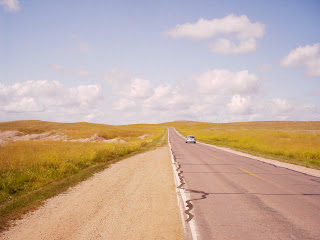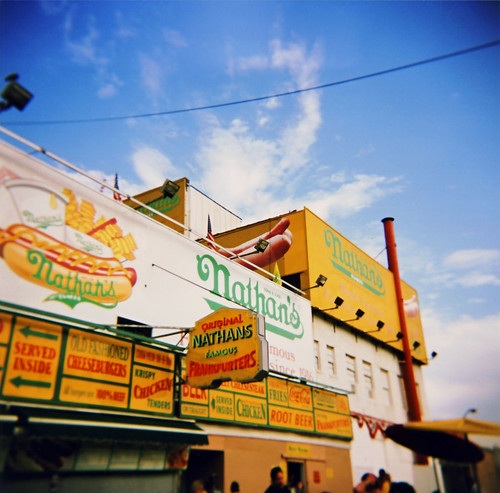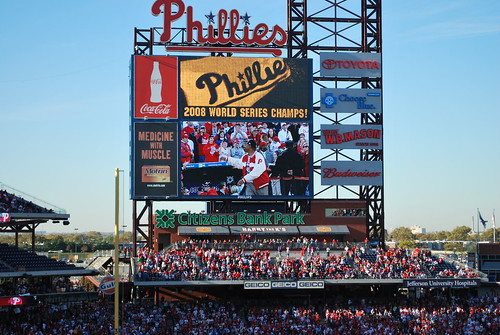
Today we saw the last of Wyoming, driving from Casper east to Lusk and then up to Newcastle. There we picked up America’s Tourist Trap Highway and went into the Black Hills of South Dakota.
This is as good a place as any to mention our evolving observations on western xenophobia. As we’ve gone along, we’ve been taken for drug dealers, undercover cops, recipe and decor poachers, and just plain weirdos. (So far, however, we have not been taken for homosexuals, which was a theme of the 2007 trip.) Rob’s theory, which I agree with, is that what we’re really being taken for is strangers: the places these things have happened are not typical tourist destinations or places where a steady stream of unfamiliar faces is expected. Instead, it’s been back roads, small-town diners, and other places mostly frequented by locals. And given the size and nature of some of these towns, the locals are long-timers, too, if not relatives. So when a couple guys come in looking “funny,” we become a canvas for what’s most feared in that place. I don’t mean by that that we’re fearsome (hardly); just that in a place where people fear getting busted, we get sized up as cops, and where they fear drug runners, we become that.
Now, what do I mean “funny”? After all, we’re not dressed outlandishly, don’t have aggressively distinctive accents (even if Rob does pronounce the word for the day before today as “yestiddy”), don’t have Day-Glo hair, or anything like that. But the codes of normality are very region-, town-, and location-specific. When we were in Cheyenne, we went minigolfing on the outskirts of town, in the middle of the day. There was a couple of guys behind us who seemed to be locals, and they wore blue jeans, big belt buckles, and T-shirts decorated with motorcycle logos and so on. We had jeans, too (mine were black, not blue), but button-down short-sleeved shirts without logos. From what’ve seen, the more acceptable variant on this is collared golf shirts and khakis, usually with a cell-phone holster. That would have typed us as, I don’t know, maybe air-conditioning salesmen, and we might have passed a little better. As it was, we looked like what we are: guys from contexts where logo T-shirts are not everyday wear. No one gives a crap whether we’re from L.A., New York, D.C., or wherever. What we were broadcasting, though, was our lack of participation in the dominant culture here—which is, of course, the dominant culture in most of America.
I’m probably making too much out of this one contrast. But it’s been interesting to see that we send signals even when we are trying to send no signal, and that we are being read everywhere we go. Certainly, no one we have met seemed surprised to hear that we were from far away. It’s easier to lose sight of this phenomenon when you’re in an environment that feels like home, but I know that for me it’s always a small shock to know that I am being watched even as I am watching. Indeed, one of the explicit points of this kind of trip is to go watch things. The things look back, though--and usually aren’t things.
We stopped at the Crazy Horse monument, which has progressed since I last was there in 1988. (This is Korczak Ziolkowski’s mad scheme to carve a mountain into the largest three-dimensional sculpture in the world.) The biggest change has been in the peripheral environment, however—there’s a huge visitors center and a consciously upbeat attitude: not only will this mountain get carved, they say, but there’ll be a museum, a university, a medical center, and so much more. Twenty years ago, it was much more threadbare, and it was reasonable to suppose that at some point the last member of the Ziolkowski family would say to hell with it and walk away. Now, it’s a real station on the Mount Rushmore pilgrimage, which I guess is OK. Who am I to second-guess such a project?

Rapid City turned out to be a misnomer—at least if Tally’s Restaurant there is any measure of the place: mediocre food, baffled service. But this was just fuel for the next stop: the Badlands.

When I came through 21 years ago, I thought this was one of the most unearthly landscapes I’d ever witnessed. But now it strikes me as precisely the opposite. What is more of this earth than these geological monuments? It’s our intrusions on it—and our perceptions of what constitutes “normality” in a landscape—that are ephemeral, constructed, and peculiar.
We wrapped the long day of driving with… no baseball game. We made it to Chamberlain, on the banks of the Missouri River, and had a darn fine meal at Al’s Oasis: whole fried catfish, wild rice, salad, and a dish of bread pudding. Tomorrow we’re on to Minneapolis/St. Paul—finally, real eastward progress.

















































